In many practices, nurses will carry out dental checks during nurse clinics. It is important to remember that a conscious oral examination will not give a full picture of the cat's oral health, but it will provide a clue that all is not well. Before performing the examination, there are some points that the registered veterinary nurse (RVN) needs to consider, to ensure they get the most out of the oral examination. It is important to remember that there are other structures in the oral cavity that will need examining other than just the cat's teeth. The oral cavity includes the tongue, the teeth, the salivary glands (buccal molar and lingual molar), hard and soft palate, the mucosa (labial, alveolar and sublingual), the lingual frenulum and the gingiva, all of which can be affected by illness or injury. Not all cats will allow visualisation of all oral structures, especially the sublingual mucosa and the lingual frenulum, but it is important to check these if the cat allows. They will also need to feel for any enlargement of the facial and pre-scapular lymph nodes as this can be a sign that the cat is fighting an infection.
The RVN will need to check previous dental charts and history to see if the patient has had dental work in the past. The history may also tell them whether the client carries out any oral care at home (Figure 1).
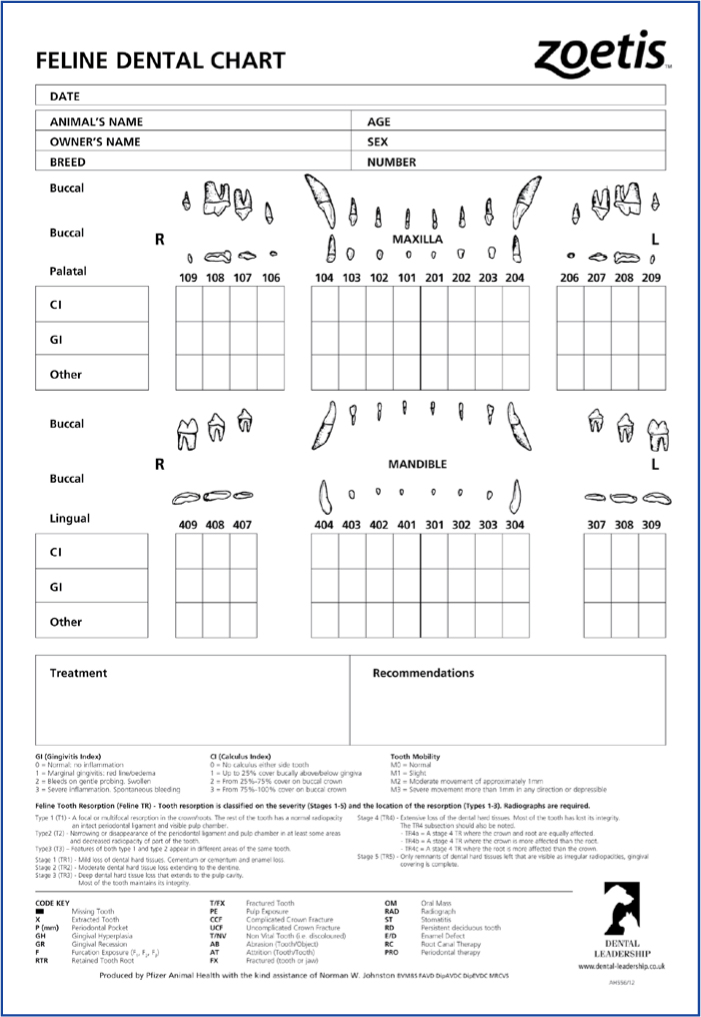
Feline patients get a lot of their comfort from their surroundings and can feel insecure in unfamiliar surroundings. The RVN will find their patients will be more co-operative if they give them time to come out of the carrier to explore the consultation room before the examination, especially if the patient does not travel well. This is a great opportunity for the RVN to collect history from the client to see if they have noticed any signs of oral pain or discomfort at home such as pawing at the mouth, difficulty eating or sensitivity of the mouth. Before touching the patient, they should take a step back and look at the cat. Are there any facial swellings? Are there any facial asymmetries? Any nasal or ocular discharge? Signs of excessive drooling on the chin or forelimbs? Has the cat been grooming itself?
The RVN may find it easier to examine the cat with another nurse gently restraining it. Many cats respond better with minimal restraint. It is also best to place a towel on the table as many consultation tables are cold and slippery. Some cats will respond and feel more relaxed if a towel pre-sprayed with a pheromone is used (Pereira et al, 2016) (Figure 2).
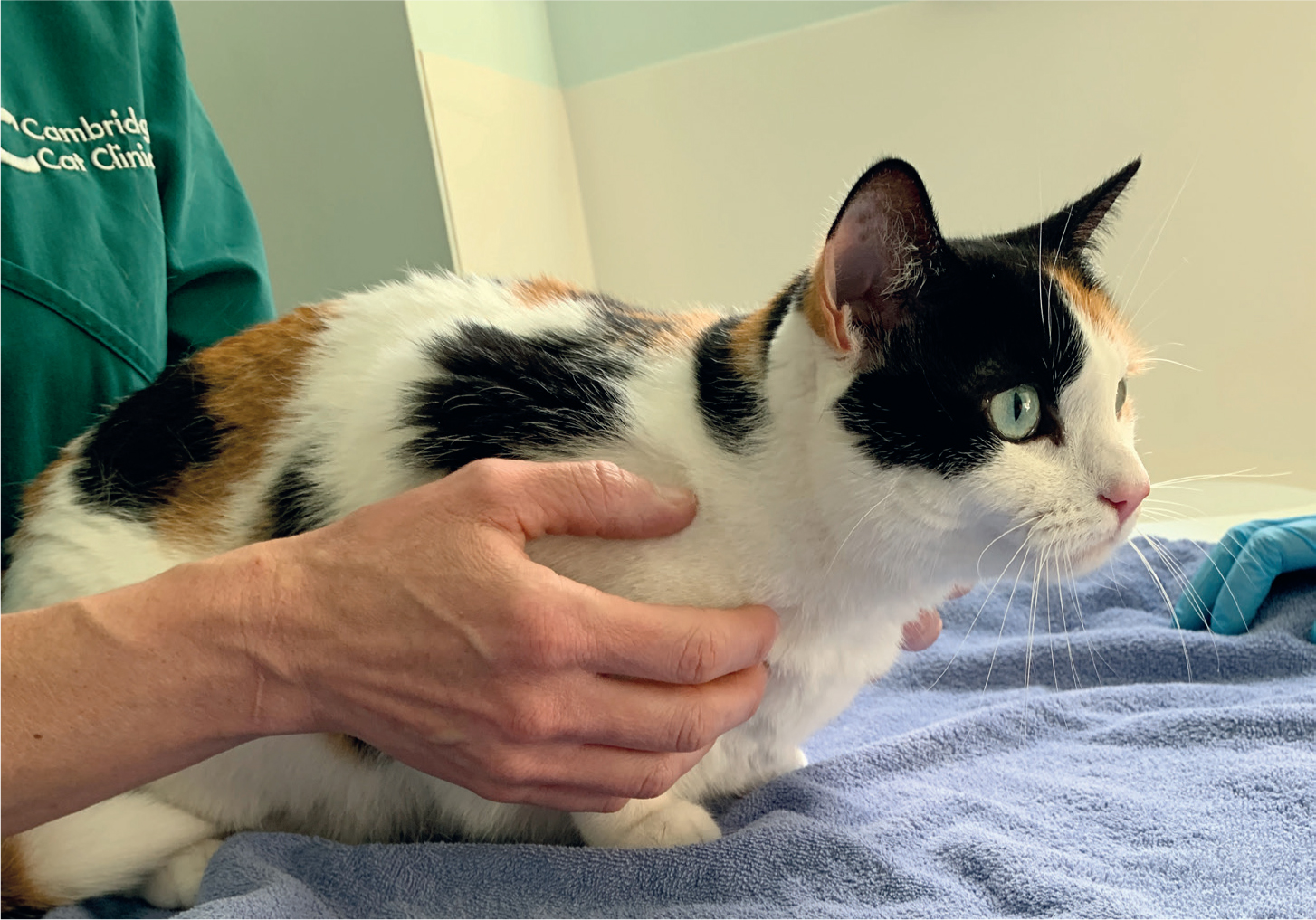
Examination
A gentle way to examine the teeth is to use one hand to expose the cat's maxillary teeth and the other to expose the mandibular teeth. The first step is to place one hand on top of the cat's head and using the thumb, lift the lip up and caudally so that it is possible to see the premolars and molar. Then while tilting the head slightly back, use the other thumb to pull the lower lip down making sure to check the mandibular third premolars (307, 407), as these are often hidden by the lower lip. This technique will also allow the visualisation of the buccal surface of the teeth, the labial and alveolar mucosa and gingiva. This needs to be repeated for both the left and the right side (Figure 3).
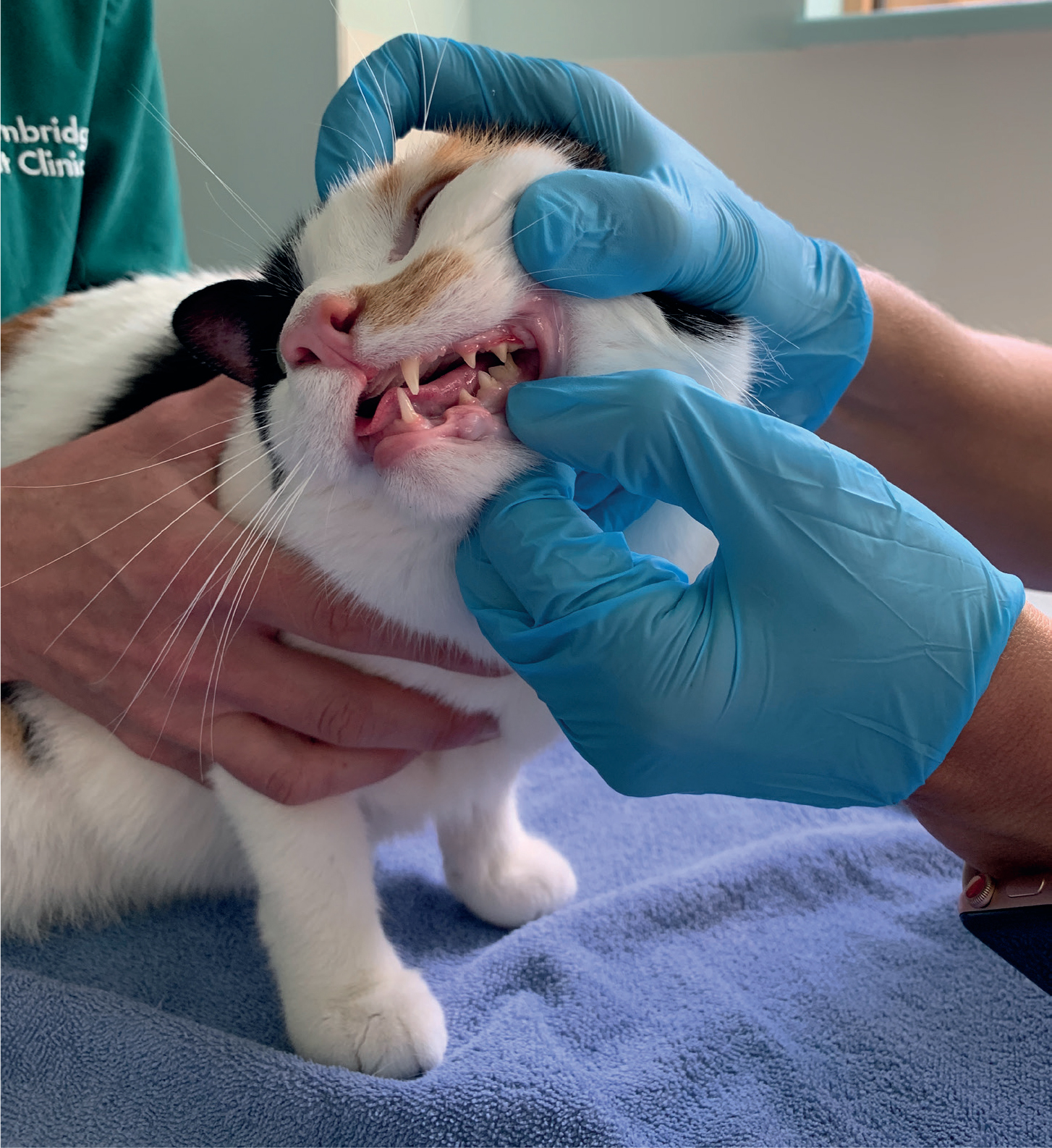
To look at the cat's oral cavity, it is necessary to place one hand on the cat's head and using the thumb and forefinger lift the lips ventrally to show the maxilla, and with the other hand, place the forefinger on the mandibular incisor area and gently pull the lower jaw ventrally while tilting the head back. This will allow visualisation of the tongue, salivary glands and the hard and soft plate. It may also be possible to see the sublingual mucosa and lingual frenulum which are located under the tongue. Do not worry about visualising these too much as only a small number of cats will allow visualisation of these structures conscious. Also note if there is any pain, crepitus or reduction in movement when opening the jaw.
Clinical signs and problems to look out for
Teeth
The RVN should count how many teeth the cat has. Is the cat missing any teeth that have not been previously extracted? This is important to know as the tooth may have fractured, leaving behind the root. This can be painful for the cat and can also cause gingivitis. Some cats may have more teeth than they should. This can mean that they have retained deciduous teeth, therefore it is important to check for these during adolescent checks (their adult teeth usually erupted by 7 months) (Muylle, 2019). This can cause problems such as overcrowding and alinement issues with the adult teeth. Cats can also get extra adult teeth known as supernumerary teeth. These can also cause overcrowding and misalignment. The mandibular fourth premolars are the most common teeth to be affected by this (Berg, 2011).
The RVN should check the teeth for any fractures especially the canines as these are the teeth mostly affected; check if the fracture has exposed the pulp cavity. Fractured teeth with pulp exposure are always painful. Monitoring these teeth is never appropriate at home or at the veterinary clinic as treatment is always needed. They will also need to be checked to see if they have become discoloured as this can mean that there has been pulp necrosis: the tooth has died or is dying due to trauma. The most common outcome of this is a progression into a tooth abscess.
The teeth need checking for calculus build up. The RVN will need to mark the amount of calculus build up, using a generic system known as the calculus index (Figure 4) (Bellows, 2010).
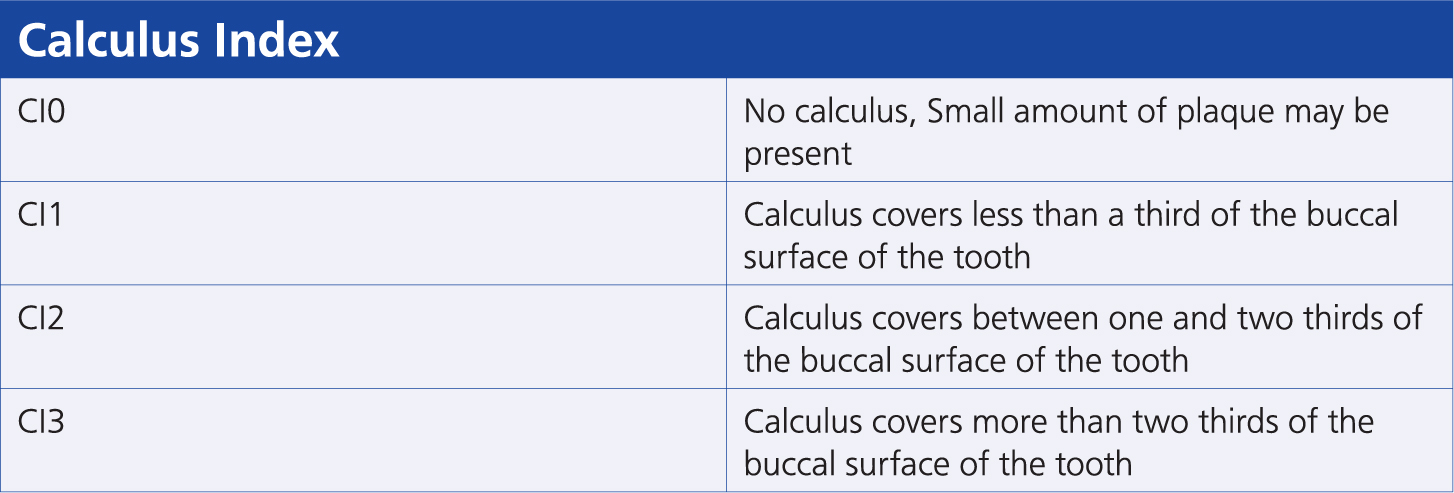
Check the teeth for any signs of a resorptive lesion. As well as having periodontal disease, 29% of cat suffer with resorptive lesions; this increases to 54% of cats that see the veterinary surgeon for a dental procedure (Ingham et al, 2001). There are two types of resorptive lesions — type 1 and type 2:
- Type 1 lesions tend to occur at the furcation and will generally only show as inflamed gingiva. The veterinary surgeon will be able to diagnose these using dental radiography.
- Type 2 lesions can often become visible as a pink discolouration of the crown. If the enamel and dentine have become affected, the tooth may appear to have granulation tissue on it (Milella, 2013) (Figure 5).
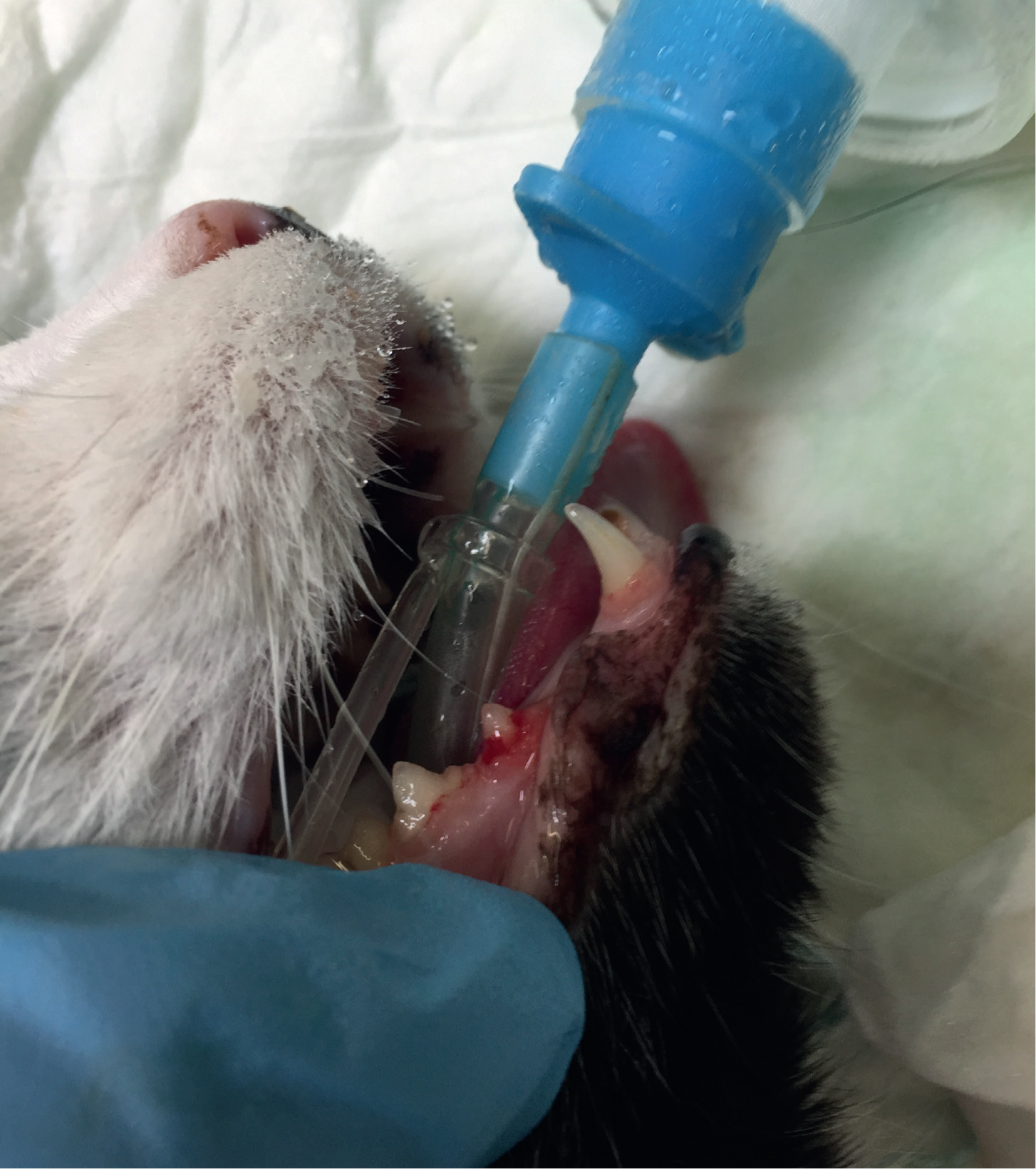
The most common tooth to be affected by resorption is the mandibular 3rd premolars (407 and 307), so it is important to examine these teeth by gently moving the lip down (Bellows, 2010).
The cat's occlusion will need to be assessed. The RVN will need to lift the maxilla lip up and the mandibular lip down without opening the jaw to see how the teeth naturally sit. A normal occlusion involves the incisors touching and the maxillary incisors slightly more rostral than the mandibular incisors. If the maxillary incisors are caudal to the mandibular incisors then it is known as mandibular mesioclusion, this can sometimes be seen when looking at the cat face on. If the maxillary incisors extend far forward of the mandibular incisors, then it is known as mandibular disocclusion. In brachycephalic breeds such as Persians and Himalayans a mandibular mesioclusion is considered normal however if they have a mandibular disocclusion then this is not considered normal (Bellows, 2010).
Gingiva
Examine all the gingiva for signs of inflammation (gingivitis). The RVN will need to grade the gingivitis using a generic system such as the gingival index (Figure 6) (Bellows, 2010). Grading the gingivitis will tell the RVN whether home treatment is working or help determine the correct course of treatment. In severe cases of periodontal disease, there may be some gingival recession. If the cat allows, the RVN can perform the cotton bud test. With a moistened cotton bud, gently roll the bud along the gingiva to see if any bleeding occurs.
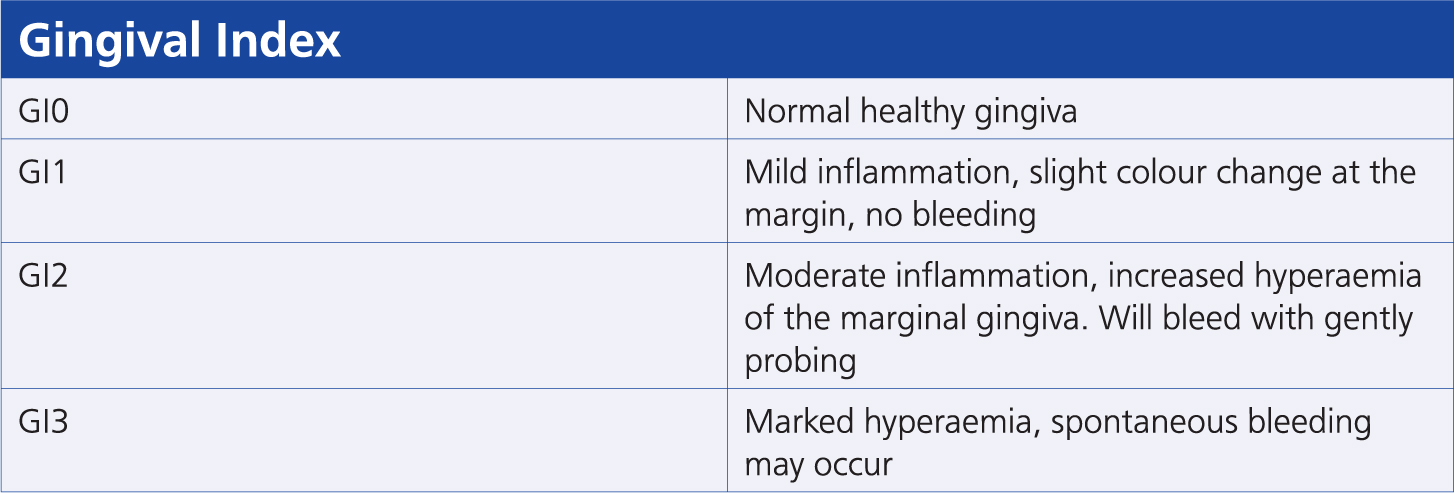
In adolescents it is important to check the gingiva for signs of juvenile hyperplastic gingivitis, which is where proliferative tissue covers the teeth but does not affect the rest of the oral cavity (Beebe, 2019). Juvenile hyperplastic gingivitis can cause issues with chewing and is painful (Bellows, 2010). If left untreated it will lead to juvenile periodontitis and loss of teeth.
Soft tissues
The mucosae need to be checked for any signs of inflammation, trauma or ulcers. It is important to check the alveolar mucosa for ulcers as this is a common area to see ulcers, if a malocclusion is seen. The ulcer is caused by the impingement tooth meeting the opposite jaw's mucosa. This can be painful so treatment is always required (Figure 7).
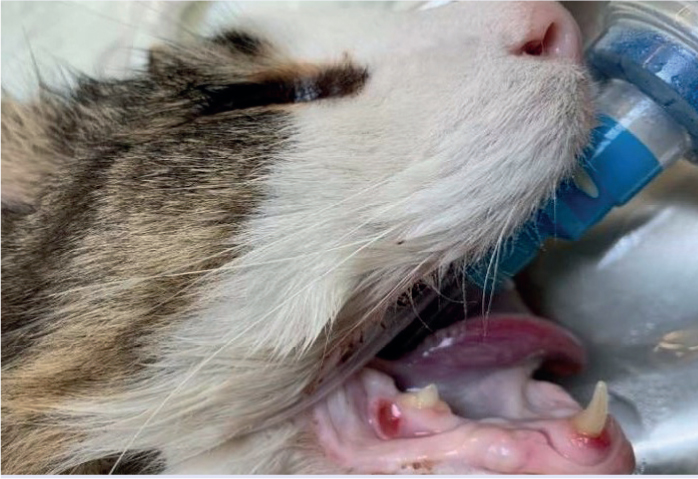
Masses can occur in the oral cavity and cause problems with eating and grooming. There are many different types of masses that can occur, some may be seen on the outside of the oral cavity, whereas others can only be seen during an oral examination (Figures 8 and 9).
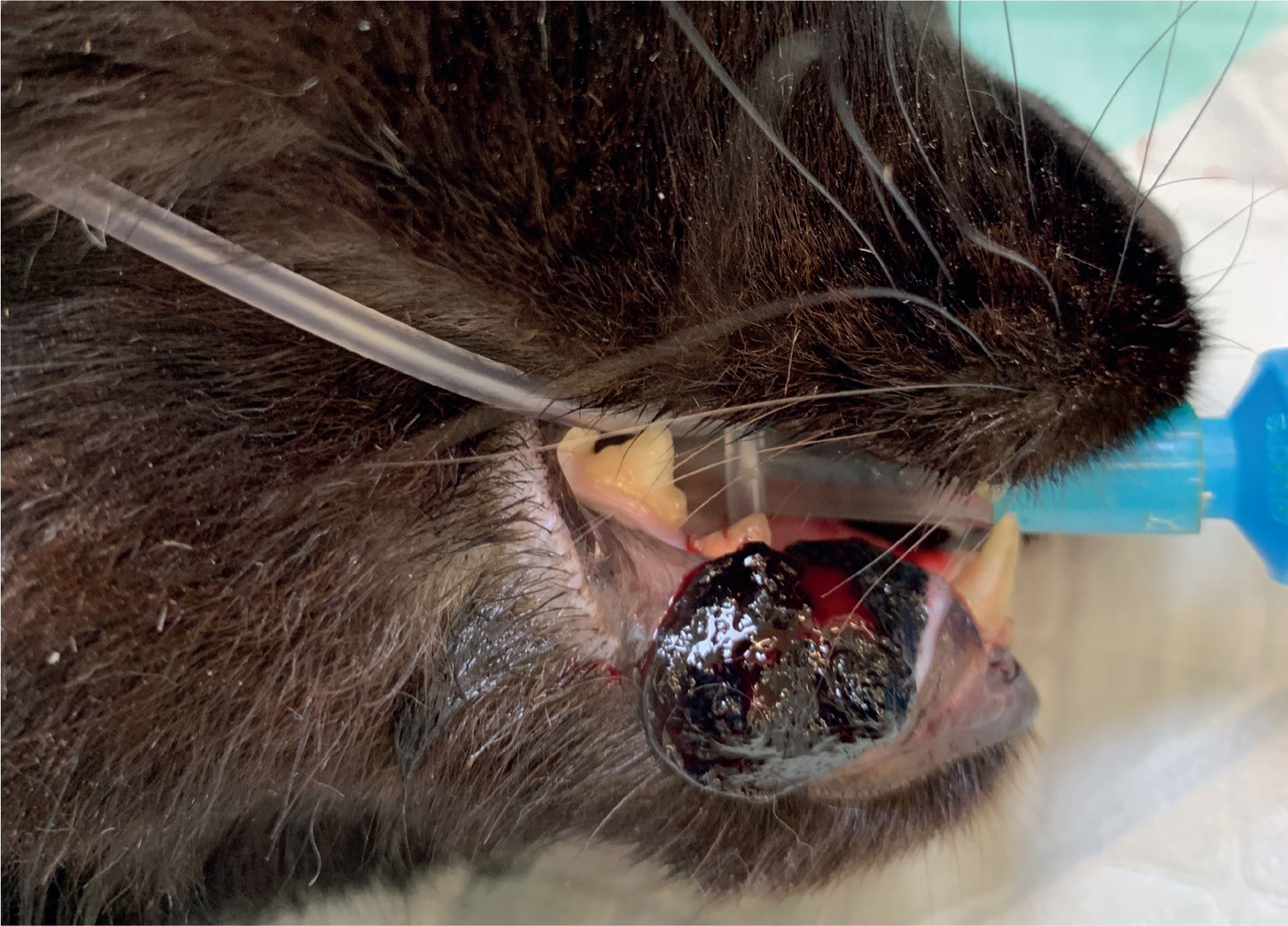
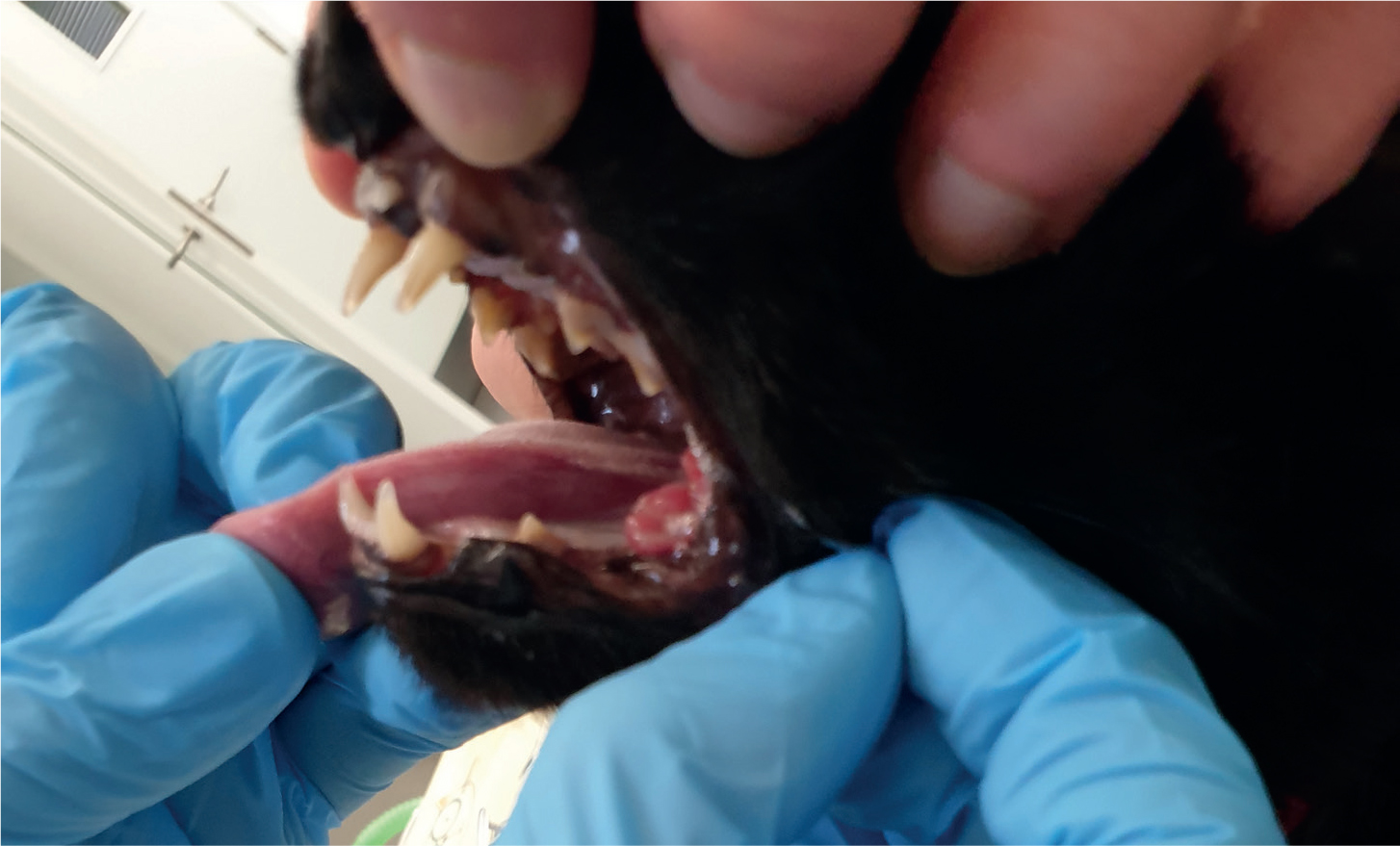
Check the tongue and throat for signs of ulcers and inflammation. This can be an indication of stomatitis. This is a very painful condition and the cat may show other clinical symptoms, such as anorexia, weight loss and dysphagia (Milella, 2013).
Cats can get ulcers on the ventral part of the maxilla lip, which can be an eosinophilic ulcer (also known as an indolent ulcer). These are thought to be non-painful and non-pruritic (Barnard, 2013). These can be a reaction to something in the cat's environment including fleas; there is therefore a need to check the cat for fleas and to ask the owner when it was last treated for fleas.
End of the examination
Once the RVN has completed their examination, they need to write down all their findings on the patient's record and also on to a dental chart. This will allow monitoring of the efficacy of home care and progression of dental disease, in an objective manner. It will also help other members of the veterinary team to see if any findings are new or if they have already been noted.
Conclusion
Oral issues can affect cats at any age and is an important part of any health check. Regular dental checks with RVNs are a useful way to monitor a cat's oral health. There are many factors to look for during the examination. It is important to remember that RVNs cannot diagnose disease in patients, however they can help owners to know when oral home care is the appropriate choice or when they will need to see a veterinary surgeon to discuss further diagnostics or treatment.
KEY POINTS
- Conscious oral examinations are not just about looking at the teeth.
- The registered veterinary nurse will get more out of the oral examination if they allow the cat to relax before performing it.
- Checking the cat's previous history and dental charts is a vital step.
- Oral issues can affect cats at any age.


